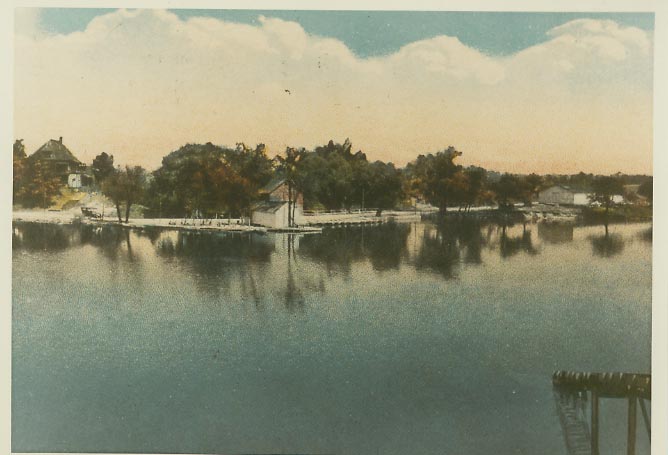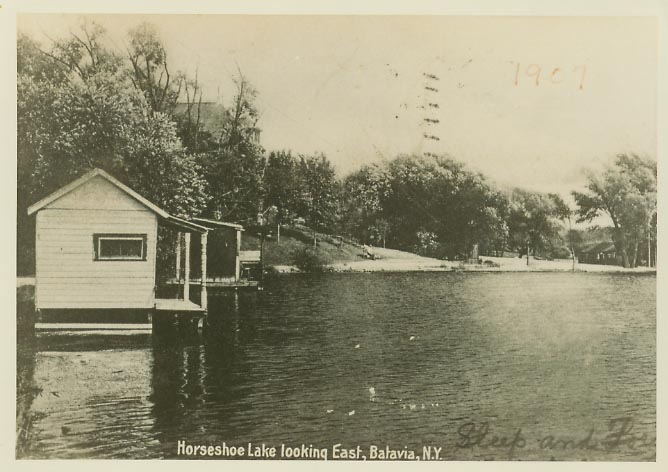ABOUT
ABOUT HORSESHOE LAKE

Horseshoe Lake is a part of the Bigelow Creek system. Bigelow Creek starts in the south west part of Stafford from springs among which are the springs that give a name to the Seven Springs settlement and the springs that supply water for Seven Springs Water. The creek then flows in a north-northeast direction through what is now Horseshoe Lake, then through what is now Godfrey’s Pond and so to Byron where it empties into Black Creek.
There was probably nothing at this spot when the first settlers came to the area; there may have been a wide place in the creek or a marshy spot but certainly no body of water. In 1831 a man named Robert Fisher who had a mill on Black Creek came over from Morganville and put a dam in the stream at a spot where it begins to drop down sharply for about a half mile before it passes under what is now Route 33. This backed up the water into a small millpond, which was called Fisher pond for the next 50 years. Fisher built a mill on the north side of the road, never a busy mill, but the only commercial building on that stretch of the road for many years. A good many years later someone built a small tavern called The Grove, on the north side at the road in the elbow where the road turns north to join Route 33. The Grove was a popular dancing spot for a few years, offering dances twice or three times a year, the History of Stafford tells us.
We do not know that The Grove suggested a new use for the mill-site to the next owner, but it seems possible. In 1890, Charles 0, Hodges bought the mill property and the pond as well as a large parcel of land on both sides of the road and stretching to the south for some distance. Hodges first raised the dam to hold the water back making the crescent shaped lake that we know today, the dam has been raised several times since 1890, but although there is a good deal more water now in the lake, the shape is much as Hodges knew it. He gave the new lake the name Horse Shoe Lake, although wits liked to refer to it as Hodges’ Ocean. In response Hodges called the new tavern he built on the mill-site The Sea View. He built horse sheds that could shelter 100 horses, apparently preparing for an influx of visitors to his lake resort. He built bathhouses for men and women, a boat landing and boathouses for the boats that he offered for rent. There was a baseball field and a cleared area for assembly meetings that Hodges’ advertising said would accommodate 5,000 people. He also offered 14 acres of woodland high above the lake for nature lovers to enjoy.
 This was a time when the ordinary family did not go away for a vacation. The Richmonds moved from one of their several residences to another occasionally, and Kate McCool and her mother went to Europe about once a year, and in between times visited spas or health resorts, but most people stayed at home. But everyone benefits from a change of scene, and it was common practice for a fraternal or insurance organization to offer an excursion occasionally to members. The organization would find a place that would take the number of people that seemed likely to go with them and would supply the transportation, in that way making a little money for the treasury.
This was a time when the ordinary family did not go away for a vacation. The Richmonds moved from one of their several residences to another occasionally, and Kate McCool and her mother went to Europe about once a year, and in between times visited spas or health resorts, but most people stayed at home. But everyone benefits from a change of scene, and it was common practice for a fraternal or insurance organization to offer an excursion occasionally to members. The organization would find a place that would take the number of people that seemed likely to go with them and would supply the transportation, in that way making a little money for the treasury.
There were several places near Batavia where large parties could go. The nearest was probably Meadow Park, on the Tonawanda to the south of the village and local people often went by excursion boat from Andrews’ Dock to the park. Excursions took people to Whiskey Run, the location of which we have no information about except that it was to the south of Batavia. It may have been only a baseball field. Groups went to Jack’s Island, west of Batavia for clam bakes. Clarence Boldt built a park on the corner of Clinton Street and Seven Springs Road, apparently the start of the present golf course. Trips to farther spots went to Olcott Beach on Lake Ontario and to Sea Breeze near Rochester. The most popular parks were Horse shoe Lake and Godfrey’s Pond.
The Daily News reported in 1890 that a Salvation Army party of 107, mostly children, had been at the lake. There was a Temperance Assembly there in 1891. The Hibernians, the Masons, the Knights of Pythias and the Odd Fellows all arranged excursions for their members to the Lake. The Owls occasionally camped there. On one summer day in 1895 there were three Sunday school picnics at the Lake on the same day.
The season would open in late May or early June with an orchestra on the boat landing in the morning and fireworks at night. In between the orchestra would play in the Sea View for dancing. There might be some extra entertainment but this was not guaranteed. Hodges owned horses that he allowed to swim in the Lake, and people enjoyed watching then swim. He owned one horse known as the Wonder Horse. He would line up twelve boats, all filled with people, and the Wonder Horse would draw then around the Lake. One summer two young men put up a trapeze bar and gave trapeze exhibits over the water. But most of the entertainment was self-provided: resting, talking, eating and dancing. There was little swimming in the 1890s as few local children, and particularly girls, had opportunity to spend time near a safe swimming spot. For most young people the chief entertainment was dancing. The Daily News would report on Monday the number that had been dancing at the Lake the Saturday night before, 65 couples early in the season. 75 couples a few weeks later, 103 couples nearer the end of the summer. Horse Shoe Lake was primarily a summer resort but Hodges provided a skating area some winters and offered winter dances.
Godfrey’s Pond was then a rival resort and in December 1891 both places planned a winter dance on the same night. Gentlemen from Godfrey’s Pond hired a carryall to take dancers to their dance, parking it on Main Street in front of the parker House (as near as we can determine this would be about where Caito’s Liquor store is today, or perhaps Rotary Park). Some gentlemen from Horse Shoe Lake came by, and learning what was afoot, went over to the livery stable and hired a number of rigs which drove by the carry-all and picked up about half of those waiting to go to Godfrey’s Pond, and took them to Horse Shoe Lake instead.
About 1903 Capt. Lina Beecher, an engineer and inventor, who lived for a few years in Batavia, organized a company that proposed to sell Horse Shoe Lake water to Batavia. This brought a protest from the New York Central Railroad, owners of Godfrey’s pond, as they feared that if any amount of water were taken from Horse Shoe Lake it would affect the supply at Godfrey’s pond. The railroad depended on this water to water their engines after the climb up the Byron grade. Batavia did not accept Beecher’s offer, and he then made the same offer to Medina and then to Lockport. When he could find no demand for his water Capt. Beecher sold the company and soon left the area. We have found no further mention of the Horseshoe Lake Water Company in the Daily News.
Hodges named his lake Horse Shoe Lake, and more recently it appears on maps as Horseshoe Lake. We are not sure just when this change took place.
Hodges owned Horse Shoe Lake for 20 years, hiring different young men to run it for him. In 1911 Anthony Fix became the manager and Hodges offered to sell the resort to Anthony Fix’s brother, Frank Fix. Frank and Anthony Fix were printers who had many other interests through the years besides Horseshoe Lake. They were the Fixes of the Fix Printing Company. In 1912 Frank Fix organized the Horseshoe Lake Amusement Corporation financed by a number of other local men. Anthony Fix and James McCormick (we believe a brother-in-law of George Watson of the Hotel Richmond). George W. Pratt and Christopher Casey (the father of the present Christopher Casey) were members of the board. James L. Kelly, a local attorney, was secretary. The new owners made many improvements, rebuilding the bathhouses, adding more boats and installing a steam launch in the Lake. They then put up billboards along roads leading to Buffalo and Rochester that read GENESES COUNTY-CONEY ISLAND-HORSESHOE LAKE. People began to come from distances away. The corporation built a toboggan slide, which was just a long chute that ran out over deep water down which the venturesome slid sitting on a board. There was a merry-go-around there for one summer. One Monday issue of the Daily News reported that there bad been a style show at the Lake the Saturday before. Louis Wiard had been in New York City and had brought back the latest in bathing costumes, which his wife and her friend Mrs. Kinne wore at the Lake the next weekend. Of course the latest in bathing costumes in 1914 bad skirts down to here and stockings up to here and a dust cap for a swim cap, but Horseshoe Lake was able to see what was being worn at the smartest beaches. Virginia Trietley wrote articles about early days in Genesee County for the Daily News for a number of years and in 1956 wrote one in which she called this period “the golden age of entertainment at the Lake.”
The corporation built two cottages in 1915 and more in 1916. The YWCA had a cottage for several summers about this time. This seems to have followed a trend, as families were no longer satisfied with one-day excursions but wanted to get away from town for a week or two at a place where their children would be safe and healthy. Looking back today this year of 1915 seems to have marked a change for the lake although it caused little notice at the time. There were still swimmers and boaters at the amusement park; dancers still came to the pavilion to dance, although dances were not as well attended, as they had been earlier. The corporation built a new dance pavilion in 1916 on the lakeshore across the road from the Sea View. They really built the pavilion twice in l916 because while they were oiling the dance floor in preparation for the opening day the oil caught fire and the place went up in a blaze. The new pavilion was ready for opening day, but must have been a hasty job that had to be done again in 1922. It was this 1922 building that became the summer Theatre of the Batavia Players in 1941.
The dance pavilion brought the first ghost to the lake. It became somewhat of a habit of some dancers when intermission came to find a boat tied up nearby and to row out into the center of the lake to cool off. After intermission they might, or they might not return the boat to its proper place. Cottagers too often had to spend a part of Sunday morning wandering along the edge of the water looking for their property. Finally someone decided to do something about it. Two young men strung a line from one of the cottages across one of the narrow inlets to a tree on the other side, and on the line they hung a nightgown in such a way that the slightest current of air would make it catch the eye, and any breeze at all would make it slide eerily along the line. Almost at once boaters saw this phenomenon and reported to other dancers that there was something unexplained out there. Two early Sunday morning fishermen also saw the unexplained object and word got around that Horseshoe Lake was haunted. This effectively stopped the misappropriation of boats, but it was also noted that attendance at the dances decreased and when the ghost interfered with profits it retired, forever.
Prank and Anthony Fix ran the Horseshoe Lake Amusement Company for 15 years, until 1926. In 1926 The Amusement Company sold out to a man from Bowmansville, Harry Pasternak. He made some changes, winterized the Sea View Tavern and renaming it The Horseshoe Lake Tavern. He offered lunches and music through the winter, along with skating on the lake. In 1928 to stimulate interest in the dances he offered a Dance Marathon. There had been a dance marathon at Crystal Beach early in the summer and others in some neighboring cities. Pasternak had Harry F. Adams run the marathon dance for him in September. They offered three prizes: one of $1,000, one of $350 and one of $150. Two couples from Batavia, Louis Fanara and Betty Nigro, Frank Battaglia and Geraldine Heale, determined that they would win first and second prizes.
The dance started at 8 P.M. on Saturday night. Dancers danced for 45 minutes and rested for 15. The Daily News says that the dance lasted 44 hours. On Monday morning there were a number of dancers still on their feet, including our Batavia friends. Early that morning a truck backed up to the entrance to the dance pavilion, loaded on dancers who were from Buffalo, and drove away. Those left behind were told that the dance would be finished at the Kit Kat Club in Cheektowaga. There was wild excitement at the lake. Cottagers had loaned blankets or pillows to dancers and were afraid that they would not get back their property. The Daily News later reported only one coat never turned up. Our Batavia dancers were most upset. They said that they had been promised payment. They declared that the dance had been mismanaged. The Sheriff, who was on the spot to keep order, called the State Police and the next issue of the Daily News reported that there had been a riot at Horseshoe Lake the night before. We believe that this is the only Marathon dance, and the only riot ever reported from the lake.
There were still dances but they ceased sometime in the ‘30s. When in 1941 the Batavia Players began to use the pavilion as a summer theatre the Daily news reported that there had been no dances there “for several years”. There were then many more cottages around the margin of the lake. Pasternak owed money here and there, including taxes and mortgage held by William Goade and when the town sold the property on a tax delinquency sale Frank Goade, William Goade’s son, bought the area now said to include 35 acres. Pasternak claimed that William Goade, as mortgage holder, should have been included in the bankruptcy proceedings, and that Frank Goade should not have been allowed to become owner. But the sale was allowed and the Goades became owners of the lake and all the land, and the family still owns Horseshoe Lake, as the present owners are grandchildren of Frank Goade. After 1941 most of the reports from Horseshoe Lake in the Daily News are of plays the Batavia Players are giving or of improvements the Players are making at the Playhouse.
The Horseshoe Lake Tavern burned in 1934. We have been told that in its last few years the tavern was noted more fot its drinkers than for its lunches or music, and the fire does not seem to have caused much regret. James Mahaney planted Christmas trees on the site and that side of the road is now solidly built with year-round homes.
The cottagers organized in 1944 and elected a mayor to administer cottage business while the Goades administered the grounds. Through some summers the LeRoy Summer Recreation Program brought children to the beach three mornings a week but no one else was welcomed. Cottagers are quiet people, and like their surroundings quiet. When you drive alone Horseshoe Lake Road today you see only No Trespassing signs on either side of the lake and have no notion of the number of cottages that are back there along the lakeshore. We have been told that there are now, in 1992, 62 cottages. No one could guess that there was once a possibility that the area might develop into a big, noisy “Fun Country”, probably not as big as Darien Lake, although both places started with a man-made lake and a picnic area. We are sure that the first cottages to be built there set the pattern the colony has followed.
But can you imagine a Ferris wheel on that level space where the playhouse once stood and perhaps a Roller Coaster up on the field to the east of the Lake? If it didn’t happen that way you can thank the Goades and the Horseshoe Lake Amusement Corporation for building the first cottages.
Ruth M. Mcevoy
8/1992
